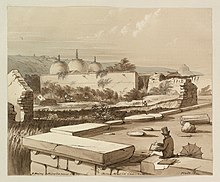
Frederick Charles Maisey (1825–1892) was an English army officer, archaeological surveyor and painter, active in India. His main painting technique was pen and ink, and watercolour.
Early life
Maisey was son of Thomas Maisey (1787-1840), of Portland Place, Marylebone, London, a painter and lithographer- sometime drawing master at schools in Cheam and in Kensington- who exhibited at the Royal Academy of Arts and was a founding member (treasurer), later president, of the New Watercolour Society.
Career
Maisey was a lieutenant in the British Army circa 1850 in the Bengal Native Infantry, and participated to the British exploration of India. Maisey was in charge of the excavation of Sanchi in 1851, working with fellow English officer Alexander Cunningham. In 1852 he also made the earliest painting of the Temples at Khajuraho.
Maisey reached the rank of General on December 1, 1888.
His son, also Frederick Charles Maisey, born on 7 July 1851, became a lieutenant-colonel in the British Army.
Works
-
 5th century Bhima pillar, Eran. Watercolor by F.C. Maisey, 1850
5th century Bhima pillar, Eran. Watercolor by F.C. Maisey, 1850
-
 General view of the Stupas at Sanchi, watercolor by F.C. Maisey (The Great Stupa on top of the hill, and Stupa 2 at the forefront)
General view of the Stupas at Sanchi, watercolor by F.C. Maisey (The Great Stupa on top of the hill, and Stupa 2 at the forefront)
-
 Relics discovered in the excavation of Sanchi Stupa No.2
Relics discovered in the excavation of Sanchi Stupa No.2
See also
References
- ^ Wright, Colin. "'Miscellaneous Series. Plate.12. Juma Masjid, Chanderi'. Maisey in a top-hat sketching in the foreground". www.bl.uk.
- ^ Hoock, Holger (2010). Empires of the Imagination: Politics, War and the Arts in the British World, 1750-1850. Profile Books. p. 344. ISBN 978-1-86197-859-2.
- A Biographical Dictionary of Royal Academy Students 1769-1830, Martin Myrone, Walpole Society, 2022
- https://www.royalacademy.org.uk/art-artists/organisation/royal-institute-of-painters-in-water-colours
- http://royalinstituteofpaintersinwatercolours.org/history
- https://somersetandwood.com/frederick-charles-maisey-mathabhanga-flat-west-bengal-india-1843-drawing-js-676
- https://somersetandwood.com/thomas-maisey-pnws-riverside-with-church-weir-early-19th-century-lithograph-js-667
- https://www.britishmuseum.org/collection/term/BIOG36906
- Singh, Sohini (June 2018). "Occidental Encounters and Impressions: The Trajectory of British-instituted Practices of Survey and Documentation in India with Special Reference to Frederick Charles Maisey's Drawings of Chanderi". Indian Historical Review. 45 (1): 58–91. doi:10.1177/0376983617750663. S2CID 149662516.
- Punja, Shobita (2010). Khajuraho: The First Thousand Years. Penguin UK. p. 17. ISBN 978-93-85890-40-6.
- London Gazette. 1888. p. 7203.